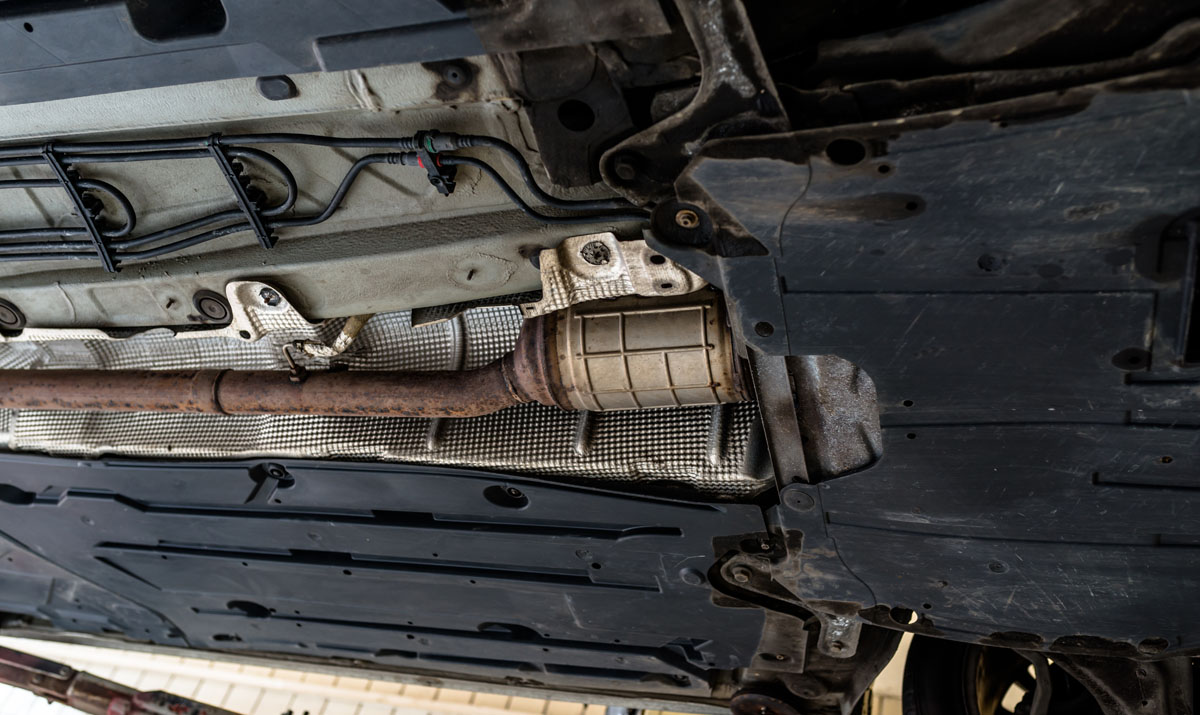The location of your catalytic converter is (usually) towards the end of the exhaust system right before the tailpipe. They take the damaging gasses that are a byproduct of the combustion process and turns them into less damaging gasses through chemical reactions prior to releasing them into the air. Nevertheless, a bad catalytic converter creates more problems than simply elevated emissions — it affects performance, occasionally to the point of the vehicle not starting. While they are typically reliable parts with long longevity, they do fail, and knowing various diagnostic methods can help you get heart of the matter.
Under (Back) Pressure
Typical signs of a catalytic converter failing includes a loss of power at idle and when you accelerate. This los of power is because “cats” generally fail when they are clogged. Because they’re lined up with your exhaust system, a clogged cat blocks the required airflow through the system completely back to combustion and throws off the correct air fuel ratio. This decreases your fuel efficiency, so you will notice a decrease in your miles per gallon. You might also notice a rotten egg smell, emanating from the fouled inner chemical device that’s been subjected to too much unburned fuel, bypassed coolant or oil. The rattling sound from inside the cat when it gets shaken is also a sign of failure.
There Has to Be Another Way
The simplest test needing minimal specialty tools is by getting the exhaust pipes connection loose upwards of the cat or removing the oxygen sensor. If you run the engine for a short amount of time with these loose (pipe) or disconnected (oxygen sensor) and there is an improvement in the condition, you are most likely looking at a bad cat. When you enable these extra passages of air, you offer a different path for air and exhaust instead of the cat. Please note that in a lot of places it’s illegal to run an engine that circumvents the cat and vents right into the air, even for a little while.
Too Darn Hot
When testing more legitimate requires an infrared thermometer. Have the engine get to normal driving temperature, about 10 minutes. Then direct the thermometer at the upward end of the cat (careful its hot) and the downward end of the cat and observe any variance in temperatures. If there’s a major discrepancy whereas the engine-side is considerably warmer, this is an indicator that the gasses are not going through.
Existing in a Vacuum
You also can utilize a vacuum gauge. Put it on a direct intake vacuum line (like from the brake booster). Be sure the vehicle is in park with the parking brake on and have a someone bring the RPMs to around 2500–3000 and hold it there as you examine the gauge. At a typical idle, you should notice a vacuum pressure of 16–21. As the RPMs increase, the vacuum should decrease, but then resume within a couple of seconds. If it remains low or takes a little time to return, that indicates back pressure.
Even if you have determined you have a bad cat, it’s vital to investigate possible hidden causes for the failure. These are typically a rich combination, blown head gasket, or something that has let coolant or oil into the system. Be sure to address this hidden problem too, or you are setting your vehicle up for another bad cat determination in the future.
An Ounce of Prevention
Regrettably, if you find your catalytic converter has failed it can’t be repaired and is required to be replaced. Get it replaced it sooner than later to avoid possible secondary damage to the engine and exhaust system, and to stop from adding to air pollution. Getting a catalytic converter replaced can be costly. A better alternative? Be wise about preventative maintenance. Retain your exhaust system’s cleanliness and well maintained to avoid cat issues before hand.
CATALYTIC CONVERTER REPLACEMENT QUOTES IN SCOTTSDALE
Our automotive mechanics can diagnose your catalytic converter and replace it if its bad. Our diagnostic process will also help identify any other matterthat might be contributing to the signs you let us know about during the consultation.
No matter what the problem is, we will find it, offer affordable rates for repair, and get you back on the road quickly! Give us a call today at (480) 948-4781, Get a quote using our contact form or stop by our automotive repair shop located at 7171 E Lincoln Dr. Scottsdale, Arizona 85253.






